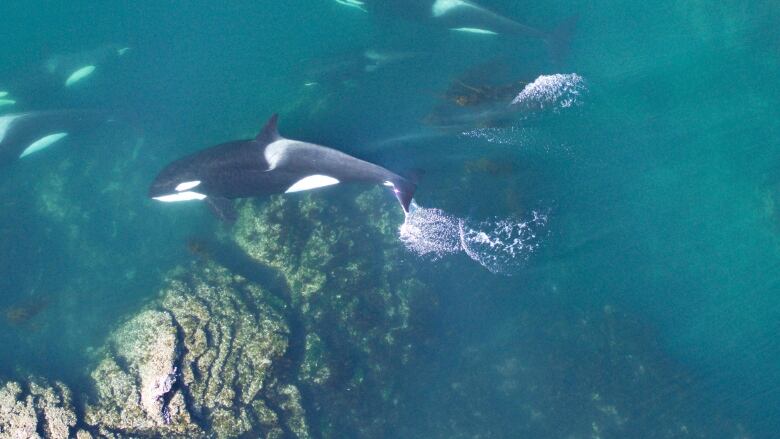Drone used to track endangered killer whales by Vancouver Aquarium
Pregnancies spotted in southern resident killer whales, an endangered group of only about 80 whales

The Vancouver Aquarium is using a drone to take pictures of killer whales off the coast of B.C., to learn whether a highly endangered whale population is healthy and the young calves are growing properly.
Last summer, researchers from the aquarium and the U.S. National Oceanic and Atmospheric Administration tracked southern resident killer whales in the San Juan Islands, continuing earlier work on the related northern resident whales.
The high-resolution images, known as photogrammetry, let researchers measure changes in each killer whale's length and girth to see if it's growing and getting enough to eat.
"These photographs are so valuable," said John Durban of NOAA's southwest fisheries science centre."Being able to monitor growth and condition of animals is a lot more powerful than just being able to monitor births and deaths."
Critically endangered whales
The southern resident population, which lives in U.S. and Canadian waters off B.C.'s South Coast, is critically endangered numbering just about 81 or 82 individuals, said researcher Lance Barrett-Lennard of the Vancouver Aquarium.
Researchers plan to use the technology to see how the individuals are faring as ocean conditions change. Southern resident killer whales depend almost entirely on chinook salmon for food, and those runs may be hurt by the dry summer and unusually warm ocean temperatures, said Barrett-Lennard.

"For the study to be really successful, however, it will have to continue over several years, because really what we're interested in here is looking at change."
The drone, called a hexicopter, weighs just over a kilogram and was flown more than 30 metres above the whales, with permits from Transport Canada and the U.S., as well as a license under the Species At Risk Act fo fly near the whales.
Pregnant whales, calves spotted
A part of that change will be in the youngest animals, after the southern resident pods saw a "baby boom" in the past year.
Durban points to a photo of a calf nursing something rarely seen from a boat as a favourite moment in the study.
"It's the meaning behind that nursing photo that's so valuable," he said, because it shows the female has enough salmon to not only feed herself but make nutrient-rich milk for the calf.
The photogrammetry also revealed several adult females that appeared to be pregnant, including J-17 in the southern resident group, suggesting more calves may be on the way.












_(720p).jpg)


 OFFICIAL HD MUSIC VIDEO.jpg)
.jpg)



























































































